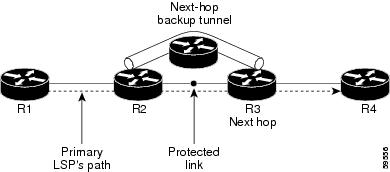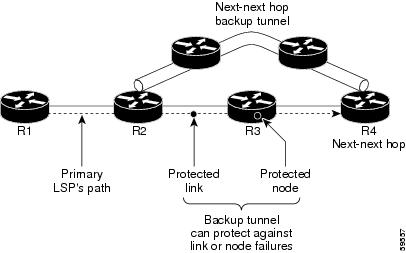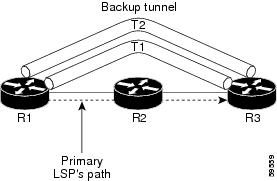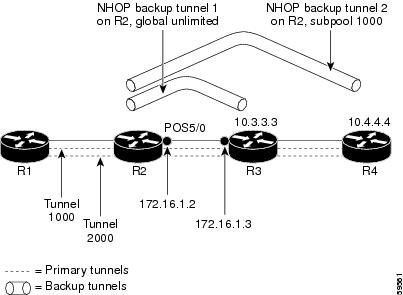There are numerous ways in which bandwidth protection can be ensured. The table below describes the advantages and disadvantages
of three methods.
Table 2. Bandwidth Protection Methods
|
Method
|
Advantages
|
Disadvantages
|
|
Reserve bandwidth for backup tunnels explicitly.
|
It is simple.
|
It is a challenge to allow bandwidth sharing of backup tunnels protecting against independent failures.
|
|
Use backup tunnels that are signaled with zero bandwidth.
|
It provides a way to share bandwidth used for protection against independent failures, so it ensures more economical bandwidth
usage.
|
It may be complicated to determine the proper placement of zero bandwidth tunnels.
|
|
Backup bandwidth protection.
|
It ensures bandwidth protection for voice traffic.
|
An LSP that does not have backup bandwidth protection can be demoted at any time if there is not enough backup bandwidth
and an LSP that has backup bandwidth protection needs bandwidth.
|
Cisco implementation of FRR does not mandate a particular approach, and it provides the flexibility to use any of the above
approaches. However, given a range of configuration choices, be sure that the choices are constant with a particular bandwidth
protection strategy.
The following sections describe some important issues in choosing an appropriate configuration:
Using Backup Tunnels with Explicitly Signaled Bandwidth
Two bandwidth parameters must be set for a backup tunnel:
To signal bandwidth requirements of a backup tunnel, configure the bandwidth of the backup tunnel by using the
tunnel
mpls
traffic-eng
bandwidth command.
To configure the backup bandwidth of the backup tunnel, use the
tunnel
mpls
traffic-eng
backup-bw command.
The signaled bandwidth is used by the LSRs on the path of the backup tunnel to perform admission control and do appropriate
bandwidth accounting.
The backup bandwidth is used by the point of local repair (PLR) (that is, the headend of the backup tunnel) to decide how
much primary traffic can be rerouted to this backup tunnel if there is a failure.
Both parameters need to be set to ensure proper operation. The numerical value of the signaled bandwidth and the backup bandwidth
should be the same.
Protected Bandwidth Pools and the Bandwidth Pool from Which the Backup Tunnel Reserves Its Bandwidth
The
tunnel
mpls
traffic-eng
bandwidth command allows you to configure the following:

Note |
Only one pool can be selected (that is, the backup tunnel can explicitly reserve bandwidth from either the global pool or
the subpool, but not both).
|
The
tunnel
mpls
traffic-eng
backup-bw command allows you to specify the bandwidth pool to which the traffic must belong for the traffic to use this backup tunnel.
Multiple pools are allowed.
There is no direct correspondence between the bandwidth pool that is protected and the bandwidth pool from which the bandwidth
of the backup tunnel draws its bandwidth.
Bandwidth protection for 10 Kbps of subpool traffic on a given link can be achieved by configuring any of the following command
combinations:
tunnel
mpls
traffic-eng
backup-bw
sub-pool
10
tunnel
mpls
traffic-eng
backup-bw
sub-pool
10
global-pool
unlimited
tunnel
mpls
traffic-eng
backup-bw
sub-pool
10
global-pool
30
Using Backup Tunnels Signaled with Zero Bandwidth
Frequently it is desirable to use backup tunnels with zero signaled bandwidth, even when bandwidth protection is required.
It may seem that if no bandwidth is explicitly reserved, no bandwidth guarantees can be provided. However, that is not necessarily
true.
In the following situation:
For each protected link AB with a maximum reservable subpool value of
n , there may be a path from node A to node B such that the difference between the maximum reservable global and the maximum
reservable subpool is at least the value of
n . If it is possible to find such paths for each link in the network, you can establish all the backup tunnels along such
paths without any bandwidth reservations. If there is a single link failure, only one backup tunnel will use any link on its
path. Because that path has at least
n
available bandwidth (in the global pool), assuming that marking and scheduling is configured to classify the subpool traffic
into a priority queue, the subpool bandwidth is guaranteed.
This approach allows sharing of the global pool bandwidth between backup tunnels protecting independent link failures. The
backup tunnels are expected to be used for only a short period of time after a failure (until the headends of affected LSPs
reroute those LSPs to other paths with available subpool bandwidth). The probability of multiple unrelated link failures is
very small (in the absence of node or shared risk link group (SRLG) failures, which result in multiple link failures). Therefore,
it is reasonable to assume that link failures are in practice independent with high probability. This “independent failure
assumption” in combination with backup tunnels signaled without explicit bandwidth reservation enables efficient bandwidth
sharing that yields substantial bandwidth savings.
Backup tunnels protecting the subpool traffic do now draw bandwidth from any pool. Primary traffic using the global pool
can use the entire global pool, and primary traffic using the subpool can use the entire subpool. Yet, subpool traffic has
a complete bandwidth guarantee if there is a single link failure.
A similar approach can be used for node and SRLG protection. However, the decision of where to put the backup tunnels is
more complicated because both node and SRLG failures effectively result in the simultaneous failure of several links. Therefore,
the backup tunnels protecting traffic traversing all affected links cannot be computed independently of each other. The backup
tunnels protecting groups of links corresponding to different failures can still be computed independently of each other,
which results in similar bandwidth savings.
Signaled Bandwidth Versus Backup Bandwidth
Backup bandwidth is used locally (by the router that is the headend of the backup tunnel) to determine which, and how many,
primary LSPs can be rerouted on a particular backup tunnel. The router ensures that the combined bandwidth requirement of
these LSPs does not exceed the backup bandwidth.
Therefore, even when the backup tunnel is signaled with zero bandwidth, the backup bandwidth must be configured with the
value corresponding to the actual bandwidth requirement of the traffic protected by this backup tunnel. Unlike the case when
bandwidth requirements of the backup tunnels are explicitly signaled, the value of the signaled bandwidth (which is zero)
is not the same value as the backup bandwidth.









 Feedback
Feedback